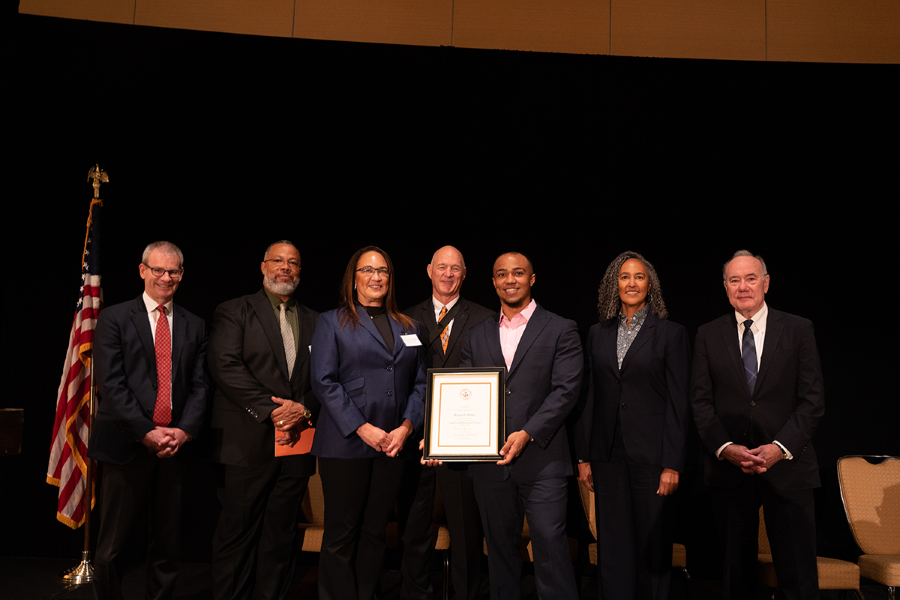Ervin S. Perry and T.U. Taylor were inducted into the Civil, Architectural and Environmental Engineering Academy of Distinguished Alumni, becoming the first posthumous inductees in the academy’s history.
Perry’s family attended the ceremony, and his induction certificate was accepted by his nephew, Kasden Perry Williams. Perry’s daughter, Edna Williams, was also in attendance, and she was happy to see her father honored by the department.
“My family and I were so excited to learn of our father being inducted to the Academy of Distinguished Alumni for the Department of Civil, Architectural and Environmental Engineering,” she said. “We were equally excited to attend the banquet and meet the other Inductees. Thank you for the recognition, and for remembering his contributions.”

The family of Ervin S. Perry attended the Academy of Distinguished Alumni Banquet on November 4, 2022 to honor his induction into the Academy. From left to right: Department Chair Bob Gilbert, Leon Williams, Patricia Perry-Williams, Academy President-Elect Jimmy Canning, Kasden Perry-Williams, Edna Perry, and Academy President Randall Poston.
Ervin S. Perry
Perry earned his bachelor’s degree in civil engineering from Prairie View A&M in 1956, and then he served as an officer in the U.S. Army until 1958. He became an instructor at Southern University in Baton Rouge, La., before entering graduate school at UT Austin in 1959, only a few years after the university started admitting Black graduate students. He left for a brief stint to serve as an instructor at Prairie View A&M.
In 1960, Perry returned to Austin and re-entered UT’s civil engineering graduate program, earning his master’s degree in 1961 and continuing on for his doctorate. One of only a small number of Black graduate students at the University during this time, he was the first Black engineering Ph.D. student at UT Austin. His research areas as a graduate student focused on materials science and structural mechanics, and he coauthored several publications on energy absorption of lightweight aggregate concrete and foamed plastics. After earning his Ph.D. in civil engineering from UT Austin in 1964, Perry joined the faculty as an assistant professor, becoming the first Black faculty member at the university and the first at a predominantly white university in the south.
Perry became the first Black member of the Travis Chapter of the Texas Society of Professional Engineers and was elected chapter director in 1966. From 1967 to 1968, Perry served as assistant to the president of Drexel Institute of Technology in Philadelphia as a fellow in the Ford Foundation Academic Administration Internship Program. He served as acting chair of UT Austin’s Civil Engineering Department in 1969 and was promoted to associate professor the same year.
Perry died of cancer in 1970. While he was only 35 when he died, his legacy will live on forever, inspiring future generations of not only Texas Engineers but all engineers to live with purpose and follow their ambitions. Each year, the Department of Civil, Architectural and Environmental Engineering at UT Austin presents the Ervin S. Perry Award to a faculty member “who best meets the ideals of an excellent teacher and good friend,” as chosen by students.
Thomas U. Taylor
Thomas U. Taylor was a civil engineer, receiving his degree from the University of Virginia in 1883 and his master’s from Cornell University in 1895. He taught applied mathematics at UT Austin, and he was the only engineering professor until 1901. In 1907, Taylor became the school’s first dean. Under him, engineering enrollment increased from 21 in 1888 to 1,443 in 1936. He signed the first civil engineering degree given by the University in 1888, and before retiring, he granted 1,699 degrees in engineering, including the university’s first master’s of science in engineering in 1922.
Taylor initiated the Big Brothers’ Fund and the Engineers’ Loan Fund, later renamed the T. U. Taylor Foundation, and he worked to establish honor and service organizations for engineering students. His personal symbol, a ram’s horn or flourishing check mark with which he marked perfect examinations, became well-known and was for a time the emblem of the College of Engineering.
Taylor was especially interested in problems of water power, irrigation and bridge construction. He was the first state hydrographic engineer for the U.S. Geological Survey from 1897 to 1912 and a consulting engineer for many public works, including the Oak Cliff viaduct in Dallas, the new Austin dam in 1926 and the state highway system. He served one term as President of the Texas Academy of Science and later Vice President of the American Society for Engineering Education. He was elected the first member of the Texas Society of Professional Engineers in 1937 and in 1940 became the first Texan elected an honorary member of the American Society of Civil Engineers.
